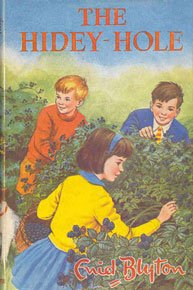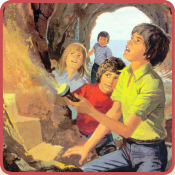
The Hidey Hole

Book Details...
First edition: 1964
Publisher: Lutterworth Press
Illustrator: Daphne Rowles
Category: Young Family
Genre: Family
Type: Novels/Novelettes
Publisher: Lutterworth Press
Illustrator: Daphne Rowles
Category: Young Family
Genre: Family
Type: Novels/Novelettes
On This Page...
Reprints
1. 1982 Sparrow, illustrations and cover by Joyce Smith and David Dowland
2. 1990 Beaver, illustrations by Joyce Smith and David Dowland, cover uncredited
3. 1991 Mammoth, illustrations by Daphne Rowles, cover by Susan André
2. 1990 Beaver, illustrations by Joyce Smith and David Dowland, cover uncredited
3. 1991 Mammoth, illustrations by Daphne Rowles, cover by Susan André

Wraparound dustwrapper from the 1st edition, illustrated by Daphne Rowles

Frontis from the 1st edition, illustrated by Daphne Rowles
It begins with Betty and Bobby and how they want to go blackberry picking with their friend, Jocko, who lives next door. They want to sell the fruit so that they can raise money to help buy a tricycle for William, a boy at their school, who we interpret as being disabled. To quote Betty's words: — "That's the boy who has poor weak legs — the doctor said that if he could have a little tricycle, it would make his legs stronger."
Their Mothers both say they will buy the fruit, and Bobby and Betty's Mother says she will pay them for any errands they do. But the children say that they do all the errands for love and don't expect to be paid. This is a fine example of how Enid taught children through her books, she taught right from wrong, respect, kindness, generosity, and most values of life.
The children, and Jocko's puppy Jiminey, go blackberry picking on gypsy common, but find that most of the fruit has already been picked, with hardly any left at all.
Fortunately, by accident, Jocko finds heaps of blackberry bushes. His puppy chases a cat through the hedge at the bottom of his garden, into neighbours, where the blackberry bushes are in plentiful. The house is owned by an elderly man in a wheelchair, who lives there alone and has a maid. Jocko, whilst trying to find his puppy, meets the maid, as she's hanging out the washing. He asks if he could pick the blackberries for the old man, but she says they're not interested in the fruit and it can rot.
This gives Jocko the idea for him and his two friends to pick all the fruit, and so this they do the following day. Whilst they're putting the fruit into their baskets, they hear the old man coming down the garden, in his wheelchair, and so Betty and Bobby, race back through the hedge, but Jocko, spills his basket, and so decides to hide behind the bushes instead.
Once the old man has gone, Jocko comes out of hiding and discovers his puppy Jiminey is missing, having once again decided to chase the cat. Jiminey has fallen down a hole under the blackberry bushes and this hole turns out to be a rather large hidey hole, which the children adopt for themselves as a secret.
The next thing we read is that the old man has been burgled and £50 has been offered as a reward. The children decide to hunt for the old man's treasures as the reward money would be perfect for Williams tricycle. They search around Whispering Wood, but to no avail.
Then Jocko finds a silver pen in their hidey hole and realizes that someone other than themselves knew about their secret place. They decide to try and discover who else has been using their hidey hole and come out early one evening to watch. They see a torch light shining from under the bush and hide just in time to see two men creep from the hole and go down the old man's garden.
Once the men were out of sight, they venture into the hole and discover all the stolen goods belonging to the old man. They collect them all together and take them to Bobby and Betty's house, knowing their parents are at home. The police are called and are proudly shown where the goods were hidden, so that when the thieves return for the goods, they find themselves captured.
The children get their £50 reward money and use it to get a specially made tricycle for William to use. Because of their generosity, the police give the children each a whistle and for Jiminy a new collar and some bones.
Enid writes at the end:- They certainly are fine whistles. I hear them being blown very loudly indeed when any of the three wants to meet the others down in that exciting hidey hole. And I think — "Dear me. Have they found another mystery to solve?" If they have I must certainly put it into another story for you.
Enid has a lovely way of talking to the reader at the end of most chapters in this book. A very clever way of involving the reader in the storyline.
It's also very clear that the children have very large gardens as the houses aren't visible from the bottom of any of the gardens.
William, who she describes as having poorly legs, probably has cerebral palsy, or suffered from Polio, some of the charities Enid was involved with. The reward of £50 was an awful lot of money back in 1964, and I can well believe that most of the money would be used for a specially made tricycle, as these mobility aids are very costly. My own grandson's specially made push chair cost almost £1500, for a basic model. But, another fine example of Enid teaching her readers that it is better to give than receive, especially for a child whose needs are much greater than theirs.
As I said at the beginning, this is an adorable book to read and doesn't take long having only twelve chapters. These illustrations are hidden by default to ensure faster browsing. Loading the illustrations is recommended for high-speed internet users only.








